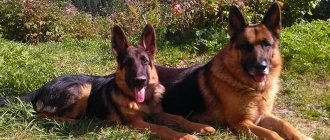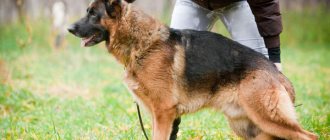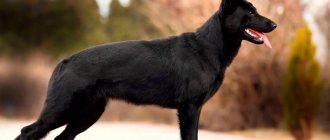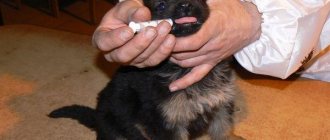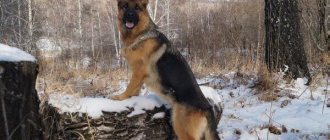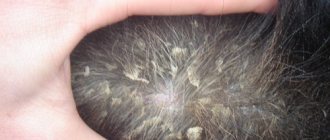Shedding in a German Shepherd
Before finding out when a German Shepherd sheds, you need to understand the types of this process. There are 3 types of coat changes:
Age-related molting
Occurs in puppies, with primary soft hair falling out and harder, spinous hair growing back. At what age does this happen? The process begins at 4 months and lasts up to a year of life.
Seasonal change
Happens all year round. In summer, shepherd dogs wear short fur with fine hairs (for high thermal conductivity). In winter, they grow long and thick fur. Molting begins in spring and autumn.
Compensatory coat change
Aimed at renewing damaged hair. It happens all the time, but its intensity is low. Hair replacement occurs throughout the body, including the face and paws, although this is not always noticeable.
Why does a shepherd lose hair?
If your German Shepherd's hair is falling out, it can be either seasonal shedding or a sign of illness. The condition of a dog’s coat depends on many factors: hormonal levels, infectious diseases, nutrition. In addition, during the life of an animal, physiological changes in the body occur, which entails age-related or seasonal changes in fur.
When does a German Shepherd shed?
With an unbalanced diet, shedding can occur in a shepherd dog for years.
Puppies shed from four months and last until they are one year old.
Usually owners do not notice this, since the puppy's coat is short and soft.
An adult pet renews its fur 2 times a year; this occurs when the temperature and day length change.
Please note that shedding can take a long time if the pet lives in an apartment, since in this case the Caucasian Shepherd is in the same conditions all year round. After all, the temperature and lighting in the apartment do not change. However, seasonality is observed, it just begins and fades smoothly, which may give the impression that the shepherd sheds heavily all year round.
Skin parasites
Hair loss and its dryness and brittleness are caused by the presence of external or internal parasites in the dog - fleas, ticks, helminths.
To prevent infestations, your pet must be bathed using special dog grooming products at least three times a year. You should use special cosmetics and care products for animals, not human shampoos or laundry soap. If you use low-quality, cheap shampoos that contain a lot of aggressive chemical components, you will only worsen your pet’s condition. In the summer, be sure to give your pet a bath without using shampoos and cosmetics. If the dog's skin is clean, not too many parasites will accumulate.
After each walk, check your pet's fur for ticks. Periodically carry out preventive treatment with special preparations from pet stores. If the shepherd lives on the street, it is necessary to wear a special anti-flea collar for prevention, which is changed periodically.
How does shedding occur in shepherds?
Normally, a dog sheds heavily for 1-2 weeks, although in pets the process can last for 2-3 weeks. To speed it up, you need to comb out the shepherd's coat and wash it regularly. This will also help get rid of mats - hairballs that greatly irritate dogs' skin. In addition, the procedure will reduce the likelihood of infection with skin and hair parasites.
Why does a German Shepherd shed in December? Most likely, the problem is that the weather is not cold enough; the high temperature in the apartment also delays the change of coat.
If everything is in order with environmental conditions, then perhaps it is a matter of estrus. Bitches often shed in front of her. Finally, if this is not the reason, then the reason lies in the lack of B vitamins.
Treatment and prevention
After the veterinarian has examined the dog and determined the causes of its baldness, a course of treatment is prescribed:
- Parasite problems are usually treated with tick and flea drops. Sometimes medications are used to rid the body of all unwanted microorganisms, including worm eggs and flea larvae. Such funds can also be used for preventive purposes.
- If a hormonal imbalance is detected, medications that normalize hormonal levels are prescribed.
- If the reason why the dog is losing hair is due to improper nutrition, the unsuitable ingredients are replaced with new ones. If you have a food allergy, you should switch your pet to a different brand of food.
- If the problem of baldness lies in weak immunity, then the veterinarian prescribes immunostimulants. To avoid immunodeficiency, you need to feed your shepherd with fortified complexes.
- It is necessary to treat antibiotics with great caution. Give your dog only those medications prescribed by your veterinarian. Antibiotics are especially effective in treating fungal and infectious diseases.
To prevent unnatural hair loss in your German Shepherd, regularly and thoroughly check the hair coat for parasites. Be careful to ensure that dirt does not accumulate in your dog's ears, and promptly clean out any secretions that accumulate in the hearing organs.
Why does a German Shepherd shed a lot?
If your pet lives outside in a kennel, then you don’t need to worry when the fur suddenly starts to come out in clumps. For such dogs, active shedding is the norm. It usually starts quite abruptly and ends quickly; dogs and shepherds shed within 7-10 days, sometimes 2 weeks.
How many months can it take for a coat change? If there is a lack of nutrients - all year round. Intense and prolonged shedding is not the norm; it occurs in cases where the pet lacks vitamins, proteins, amino acids or minerals, as well as in the case of an allergic skin reaction. The cause can be serious pathologies: hormonal imbalances, fungal diseases and skin parasites.
Hair loss in dogs
One of the indicators of a dog's health is its coat.
Smooth, shiny or thick hair often tells the dog owner that everything is in order with the dog’s health. Almost every dog owner knows that several times a year dogs experience active hair loss, the so-called seasonal shedding, during which the dog feels normal, and therefore does not worry about its health. Wool structure . In dogs, hair follicles are combined into groups (bundles) consisting of one, longest, primary (central) hair, surrounded by thinner and shorter secondary (additional) hairs (in puppies there are no secondary hairs).
The density of the coat depends on the age and breed of the dog. The softer the wool, the thicker it is. For example, a German Shepherd has 1 sq. There are 100-300 groups of follicles per cm of skin, and 400-600 in dogs with soft hair. The number of groups of hair follicles is determined at birth, but young puppies only have downy hairs that are very soft to the touch. With age, the angle of inclination of the hair to the surface of the skin decreases to approximately 45° until an adult dog.
The owner of the dog begins to worry when hair loss is accompanied by certain painful symptoms, when the dog becomes restless or lethargic, its appetite is impaired, etc.
What reasons can lead to hair loss in a dog.
Experts divide the causes that can cause hair loss in dogs into two large groups - hormonal and non-hormonal.
If you notice hair loss in your dog on symmetrical areas of the body, then the cause of hair loss most likely lies in a hormonal imbalance in the dog’s body. In the case where there is no such sequence, and hair loss occurs in different parts of the body, then you should think about whether the dog has a skin disease.
Hormonal causes of hair loss in dogs.
Hormonal causes that can cause hair loss include:
- Hyperestrogenism is an excessive intake of estrogen into the dog’s body; as a result of an imbalance of sex hormones, dog owners notice severe hair loss in the genital area. At the same time, there is a sharp enlargement of the vulva in females and swelling of the foreskin in males.
- Hypoestrogenism is a lack of hormones in a dog’s body. This disease is more common in middle-aged spayed female dogs. With this disease, the dog first experiences severe thinning of the hair near the genitals, and subsequently throughout the body; dog owners additionally note a slowdown in the rate of hair growth.
Hypothyroidism is a disease accompanied by an acute deficiency of thyroid hormones in the dog’s body. With this disease, the hair becomes dry and brittle. Then hair loss begins on the back, chest and neck. In addition, owners note that the dog is lethargic and apathetic. The dog avoids physical activity, a sharp increase in body weight occurs, and the degree of protection against various infections decreases.
Hyperadrenocorticism or Cushing's syndrome is a disease when excess cortisol is formed in a dog's body. The disease is accompanied by severe loss of hair throughout the body. Additionally, this disease is characterized by a strong gain in body weight, constant thirst and frequent urination. During a clinical examination, the dog has swelling and drooping abdomen.
What to do if your shepherd sheds a lot
You can help your shepherd get rid of fur, as well as normalize its diet. Under no circumstances should you shave your dog; your pet needs fur; without it, dermatological diseases will develop. You only need to remove the loose hair, for which you comb the shepherd dog with a stiff brush. How often to do this depends on the intensity of shedding. This procedure will help get rid of falling hair, but will not restore it to health.
The shepherd sheds a lot, what should I do? To normalize the coat, you need to balance the dog’s diet:
- The shepherd dog should eat mainly meat food; you can feed offal (lungs, bones, tripe, liver). Porridge and vegetables can be included in the diet, but they should not exceed half of the total volume in the daily portion.
- If you feed your animal with industrial food, then you cannot give your dog any other foods, since ready-made food is completely balanced in vitamins and minerals. Give preference to quality canned food in the mid-price range.
- You cannot prescribe vitamins to your dog on your own. They must be prescribed by a veterinarian. Wool may fall out due to a lack of minerals, amino acids, vitamins, unsaturated fatty acids and other elements. There are a lot of them, and only a doctor can determine which ones should be given to the dog.
Answer
Hair loss in a German Shepherd is a direct indication that the animal has health problems. It is not possible to definitively determine a pet’s disease without examining a veterinarian. Let's consider possible options for pet skin diseases and how to help your dog at home.
A dog's fur may fall out due to the presence of parasites, skin diseases, allergies and hormonal imbalances. In addition to external or internal pathological reasons, dog hair loss is caused by age.
Causes
Why does this problem arise? Dandruff itself does not always clearly indicate a malfunction in the dog’s body. There can be many reasons for its appearance, from a simple change in food or an unsuitable indoor microclimate, to serious damage to the skin by mites. To understand where dandruff comes from, you need to observe your pet.
Why does dandruff appear in dogs?
- Seasonal dandruff on the back during hair loss (molting) is a common phenomenon.
Most dogs live in apartments with central heating, which greatly affects air humidity. As soon as the air becomes drier than usual, shedding begins, which is accompanied by dry dandruff. Usually it goes away when the coat change ends. To alleviate your pet’s condition, you need to comb its fur more often, and also use conditioner when bathing. You can purchase an air humidifier - this will be useful not only for your pet, but also for other inhabitants of the apartment. - If the dog is constantly itching , then dandruff on the coat becomes even more noticeable, especially on the back. There can be many reasons for itching. This is either a food allergy, or a reaction to the bites of blood-sucking insects, or the first manifestations of eczema, seborrhea or other types of dermatitis. Skin parasites can also make themselves felt by unbearable itching.
- Stress . Dogs react differently to the world around them, and some are more susceptible to stressful situations. Stress can be anything - separation from the owner, boredom, fear, and much more. A dog can easily begin to itch due to nervousness, and it is the owner’s duty to protect his friend from nervous shocks.
- Scratching, sores, thickening of the skin in these places, severe oily dandruff, in which a lot of hair climbs and falls out - an unambiguous signal from the dog’s body about a skin disease. This could be atopic dermatitis, allergies, seborrhea, scabies, demodicosis and many other infectious and unpleasant diseases for the dog. If your pet is in this condition, you should never postpone a visit to the veterinarian!
- If the dog behaves as usual , but dandruff is normal for it, then it is worth thinking about how high-quality nutrition the pet receives.
Economy class food, food from the master's table, fatty, salty, sweet - all this should be prohibited. When choosing food, it is best to pay attention to premium food that contains the optimal amount of essential nutrients and vitamins. A good alternative to ready-made food can be preparing your own food for your dog. - A nonspecific cause of dandruff in a dog can be improper hair care, too frequent or, conversely, too infrequent washing, or inappropriate shampoo.
REFERENCE: The PH level of a dog’s skin is 8, while a human’s is 5.5. Instead of the owner's shampoo and conditioner, when bathing your four-legged friend, you need to use special products intended only for dogs.
